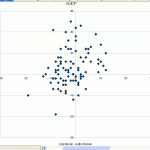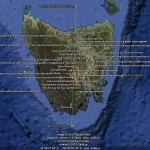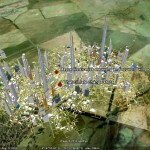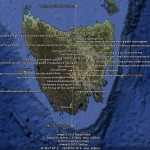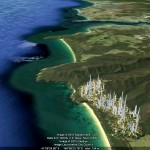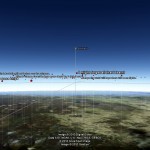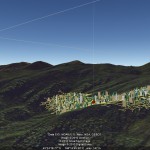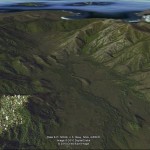A Map of a Dream of the Future: Google Earth conceptual mapping
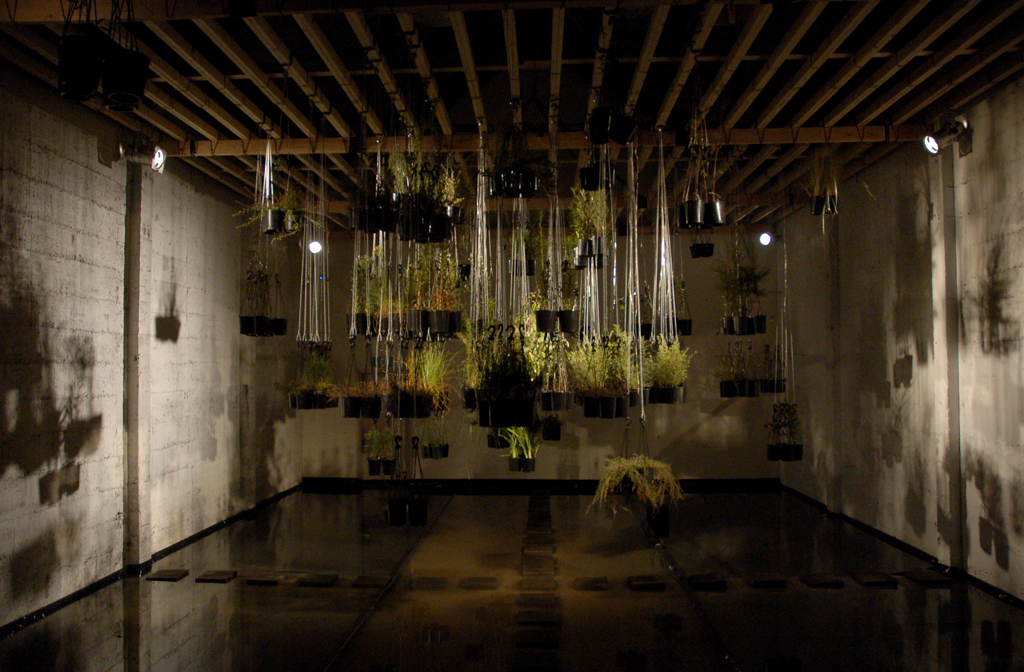
For the AMDF project, we’ve built a virtual future Tasmania. It’s a Google Earth-based data visualisation of what young Tasmanians think about tackling climate change in 80 years time. For each of the 100 year 5/6 students who completed our education kit and survey, we’ve built them a virtual future city. The x and y position of the city, plus its layout and composition, tell us what kind of future they want to live in.
- Google Earth x y scatter graph
- Virtual future Tasmania
- Virtual future Tasmania
Click here to download the Google Earth file: (3.4mb – will take a minute or so to open once downloaded due to complexity)
Here’s how it works. Basically, we’ve taken an x-y-z scatter graph (first image in gallery above) and turned it into a map with a city for each point (second image in gallery above). The axis are as follows:
X-axis: Libertarian-Authoritarian. Cities on the west coast are libertarian-anarchist kids, where they want no government involvement in tackling climate change. It’s up to each and every individual to self-organise. Cities on the east coast are top-down, authoritarian societies. They will be sustainable, whether you like it or not. There’s a slight tendency towards libertarianism amongst our sample of kids.
Y-axis: Technology-Nature. Settlements up north represent kids who believe in a high-tech, high-energy future. They have a strong faith in science, technology and as-yet unimagined gadgets to solve climate change.
Z-axis: Optimism-Pessimism. The height of the city markers tell us the level of optimism that kid has about the future. Cities with higher markers show kids who are positive about our chances to tackle climate change – they feel we are well-informed, well prepared and able to adapt – while the lower ones are less than confident about our chances.
City layout: Libertarian – Authoritarian. This is a more visual representation of his data. Libertarian cities are built in a more dispersed, decentred pattern. The more authoritarian, the more centralised around a single point.
Building height: Nature – Technology. Higher buildings = higher emphasis on technology.
Programming and design for the system comes from NZ programmer Richard Procter, who has done an amazing job in taking a concept and turning it into a working dynamic system that generates the results based on whatever data we throw at it. It’s based on an L-system algorithm he wrote, one that essentially ‘grows’ the cities across the landscape of Tasmania – first roads, then building lots, then populates them with 3D buildings. Best of all, where we have two kids with similar ideas, the system grows their cities together to form a metropolis. In this way, we get larger settlements of people forming around common interests, which is in a way how real cities are formed. If you’re interested in finding out more about the system behind this project, email Richard at richard dot n dot procter at gmail dot com.
The diagrams below illustrate the gamut of cities the system can build in google earth. They are a sample; the computer tailors a unique layout to each child’s response. This is the technology-nature axis, represented as a spectrum of city plans:
Building on the above to include the Libertarian-Authoritarian axis, the two sequences below illustrate the four extremes: the top left is natural/libertarian, and the bottom right, high tech/authoritarian. Click to enlarge.
The data for the project was generated by a survey designed by sustainability psychologist Tim Cotter of Awake and delivered to schools by Nadine Kessler, Josie Hurst and Heidi Douglas. The same data was used to create the AMDF installation – see here for photos
